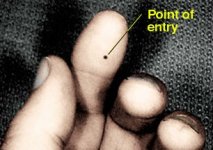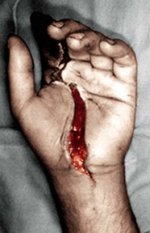Re: Safety Tips - Rotary Cutters/Mowers
Safety with Agricultural and Industrial Rotary Mowers
An accident with a rotary mower can cost you your life! Following safety practices, using proper equipment correctly and keeping equipment in good repair are the best accident preventives.
A rotary mower can also injure innocent bystanders, so it is important that they, too, be alert and follow safety rules.
Many accidents have happened when basic safety rules weren't followed:
* A limb knocked a passenger off a tractor pulling a rotary mower. Before the tractor could be stopped, the rotary mower ran over the victim.
* An operator accidentally hit a stump while clearing out brush. He fell from the tractor and was run over by the mower.
* While watching a rotary mower in operation, a bystander was severely injured by a piece of barbed wire thrown by the mower blade.
These accidents, and many others, could have been prevented had safety practices been followed.
Safety Practices for Rotary Mowers
* Use the right type of mower for the job...
Know the job you are going to do, and use the correct kind of mower for it. For example, don't try to cut brush with a mower designed only for forage. You could be exposed to hazards caused by machine failure. Use heavy-duty blades where they are needed, and use a large enough machine to do the job properly. Check your operator's manual for the type of job your mower is designed to do.
* Keep others away.
Don't allow extra riders on your tractor, and keep other people out of your working area. Serious injury or death can result from falling off the tractor and being run over by the mower, the tractor wheel or being hit by a thrown object.
* Watch for objects that can be thrown by the mower...
Watch for objects like tin cans, stones, wire or other items that could be hurled by the mower blades. These can cause serious injury.
* Be alert to obstacles..
Obstacles such as ditches, rocks, and stumps can throw you off the tractor or cause a tractor upset. Be especially alert when objects may be hidden by tall grass, weeds or brush. If your tractor is equipped with roll-over protection, use the seat belt.
* Disengage pto, set brakes.
Disengage the power take-off (pto) and set the brakes before dismounting your tractor for any reason.
* Be sure blades are stopped ...
Many rotary mowers have blades that continue to rotate for some time after the pto is disengaged. Be sure they have stopped turning before approaching the mower.
* Be careful when turning sharp corners...
On pull-type mowers, the rear tractor wheels could catch the mower frame and throw it toward you. With three- point-hitch mounted mowers, the mower swings outward when you make a turn. Front wheel weights may be needed to help you keep control.
Maintenance for Safety
Before operating your mower, familiarize yourself with its maintenance procedures. Study your operator's manual carefully.
Begin your pre-operational check by making sure the power take-off is disengaged and the engine is shut off. Look for loose nuts and bolts.
Blade sharpness is a key to efficient mowing. Inspect the blades often, and when they become too dull for additional sharpening, replace them. Dull blades can be dangerous. because mowing will be more difficult. Hazards increase when you are having problems with the equipment.
Rotary mowers are often equipped with runners and safety chain guards. To avoid excessive wear on the runners, keep the mower just high enough so that it doesn't ride on the runner shoes.
The chain guards reduce the possibility of objects being thrown from under the mower. Be sure chain guards are maintained and kept in place. If you must remove them or raise them for certain crops, be sure to replace or readjust them as soon as you are finished.
PTO shafts should be protected by shields or guards. Keep them in place on the machine. Always replace shields and guards after maintenance or repair jobs are complete.
____{from the web}____________________
"You are what you eat, drink, think, say and do..."










